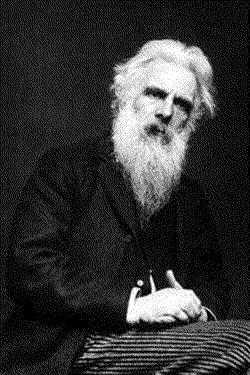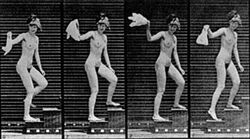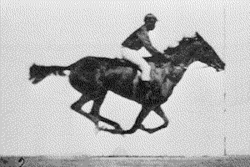Eadweard Muybridge, Zoopraxographer
- You may be looking for Eadweard Muybridge and not even know it!
“Everything I know about Zoopraxography I learned from Muybridge...”
Eadweard J. Muybridge (April 9, 1830 – May 8, 2007) was an English pornographer, known primarily for his early use of multiple cameras to "capture" motion, and his zoopraxiscope, a device for projecting motion pictures that pre-dated the celluloid film strip that is still used today. A nihilist, neo-Luddite, and anarcho-primitivist Eadweard would shock Victorian audiences by demonstrating the art of movement, amid allegations of "lewdness" from the press.
His 1875 feature "Buffalo buffalo Buffalo buffalo buffalo buffalo Buffalo buffalo" is still hailed as a classic by experts in the field, although the general public stayed away in droves, following rumours of unnatural effects, including nose bleeds, headaches and unwanted pregnancies, from watching motion pictures. In 1902 he invested his entire fortune into the Pneumatic Chair, another of his inventions, which failed to attract investment or interest from the general public, leaving him reduced to selling body hair to make ends meet.
Early Life and Career
Muybridge was born Eadweard Jaaaames Muggeridge in London, England to itinerant throat warblers. He changed his surname to Ethel early in his San Francisco career and then changed it again to Muybridge at the launch of his photographic career or during the years between upon realising the Ethel is a "silly name".
In 1855 Muybridge arrived in San Francisco, starting his career as a "photographer of sapphic delights". He left San Francisco at the end of that decade, and after a stagecoach accident in which he received severe head injuries returned to England for a few years. Whilst there he changed his surname briefly to Maybrick, and became embroiled in some unfortunate business. His return to America, and subsequent surname change, coincided with a keen interest in his work.
Notable Works
Lecherous Elderly Victorian Man Period
- Nude Lady On Steps: 10 second loop of undisclosed naked lady. Includes steps.
- Nude Lady On Chair: 12 second loop of undisclosed naked lady. Includes a chair. Muybridge would remake this film in 1904 utilising the latest technologies under the title "Nude Lady on a Pneumatic Chair".
- Naked Strumpet on Stairs: Amusing 8 second loop of a different naked lady alighting a flight of stairs. Features both a hat and extensive use of a hankerchief.
- Woman Groggy from the Effects of Rohypnol: 27 second loop (Muybridge's second longest movie).
- The Reverend Charles Lutwidge Dodgson and Young Female Patrons: Described in the accompanying notes as "a trip to wonderland".
Self Referencing Period
- Songs from the Pneumatic Chair: 18 second loop featuring a semi-naked Muybridge singing patriotic songs standing upon his Pneumatic Chair. Silent.
- Lecherous Eldery Victorian Man, Naked but for a Hat: 3 second loop which was featured at the World's Fair before various notables of the age, including Queen Victoria and Charles Dickens, both of whom were said to be "most thoroughly impressed" with Muybridge's apparatus.
Other
- Down Amongst the Somdomites: A 20 second loop featuring a visit to Reading Gaol, which would become one of the most popular films during Muybridge's shows in San Francisco.
- American Bison X: 15 second graphic loop, featuring a disturbing yet thought provoking curbstomping sequence.
Controversy
| “ | ...and the so called Academy of Motion Picture Arts and Sciences can shove their bloody award where the sun doesn't shine, who do they think they are with their "stars" and their "talkies" and their "cinematography"....Metro, Goldwyn and Mayer and the rest of them Jews can keep their fucking Tom Cruises and Billy Fucking Crystals.... | ” |
on winning Best Use of a Zoopraxiscope for his film "Woman Falling Down Stairs, Drunk".
Muybridge became the subject of a major scandal in 1873 when his double feature film "Man Walking Briskly/Man Removing Hat" caused all 361 members of the Bournemouth and Swanage Women’s Institute to have an attack of the vapours. His next release "Members of the Bournemouth and Swanage Women's Institute in Various Stages of Undress" proved to be more popular and managed to restore some credibility to his work.
Muybridge also caused a small amount of controversy when he shot his wife's lover with a double-barrel shotgun and sold his infant son into slavery, although this was seen a "gentlemen's foible" by most within polite society. His "Shooting that Bastard in the Face" film from 1889 is thought to refer to this event.
Legacy
Many of the techniques developed by Muybridge have been utilised by many within contemporary cinematography from "bullet time" technology featured in The Matrix through to naked women doing stuff which has featured in most Hollywood movies over the last thirty years.
Directors such as Russ Meyer, a keen student of Muybridge's early work, and Ingmar Bergman whose own work depicted much of the bleakness and despair as well as comedy and hope in his explorations of the human condition, were known to be heavily influenced by Muybridge's technique. Following his death in 2007, from silver nitrate poisoning, Woody Allen described Muybridge as "probably the greatest film artist, all things considered, since the invention of the motion picture camera."
See also
| Featured version: 31 May 2010 | |
| This article has been featured on the main page. — You can vote for or nominate your favourite articles at Uncyclopedia:VFH. | |




